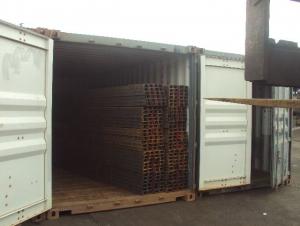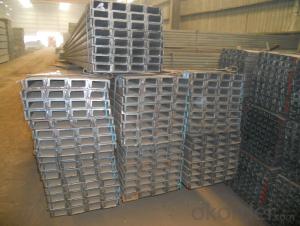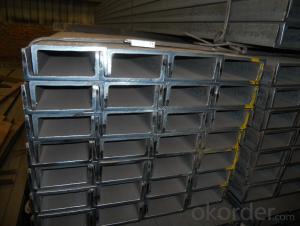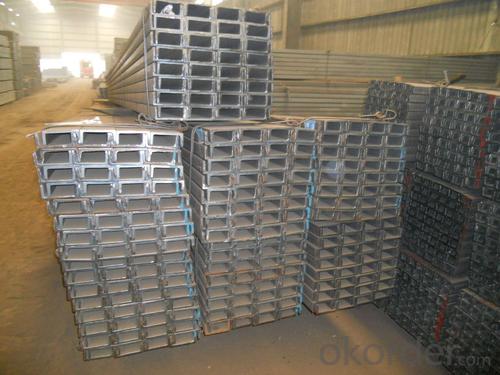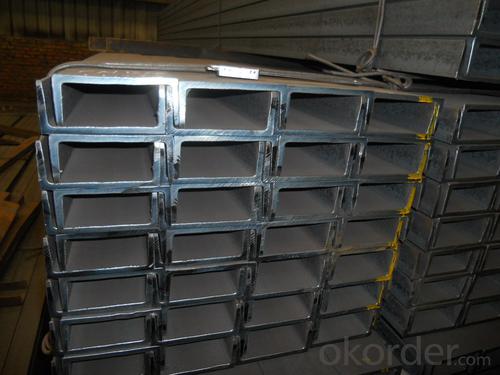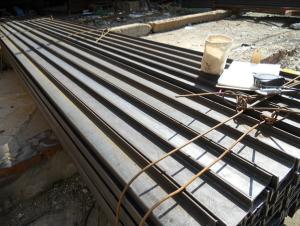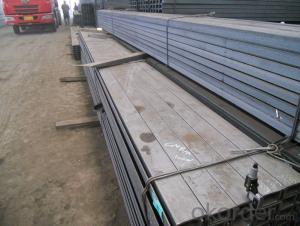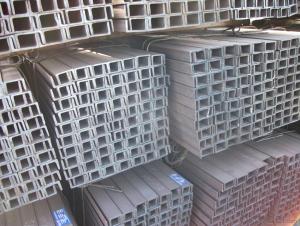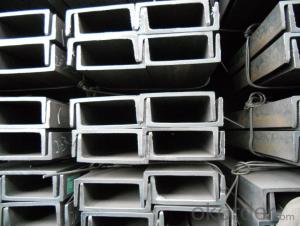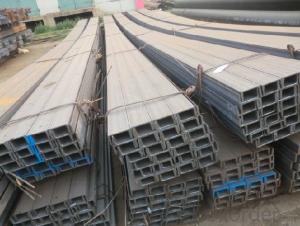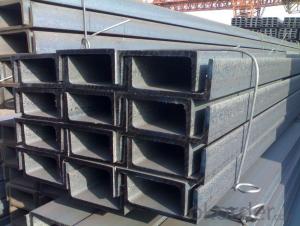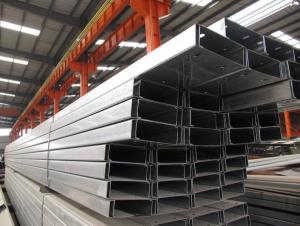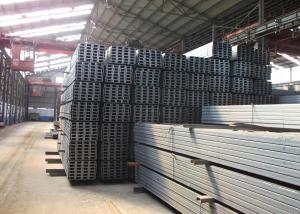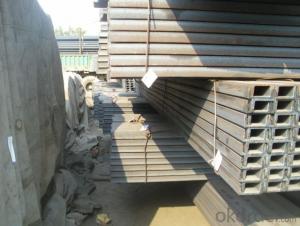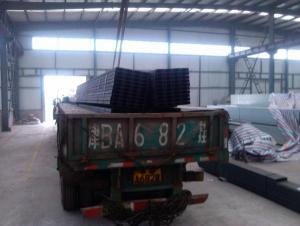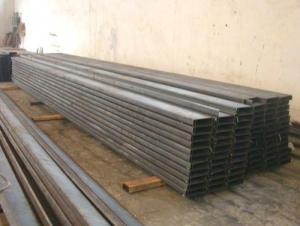U-channel Carbon Steel JIS Standard High Quality Hot Rolled
- Loading Port:
- Tianjin
- Payment Terms:
- TT OR LC
- Min Order Qty:
- 25 m.t.
- Supply Capability:
- 2000 m.t./month
OKorder Service Pledge
OKorder Financial Service
You Might Also Like
Product Description:
OKorder is offering U-channel at great prices with worldwide shipping. Our supplier is a world-class manufacturer of steel, with our products utilized the world over. OKorder annually supplies products to European, North American and Asian markets. We provide quotations within 24 hours of receiving an inquiry and guarantee competitive prices.
Product Applications:
1.The JIS channel can be devided into two kinds, namely common channel steel and light channel steel. The sizes of hot rolled common channel steel range from 5# to 40#. Meanwhile, the channel steel can be divided into cold forming sectional equal channel steel, cold forming sectional unequal channel steel, cold forming inner edge channel steel and outer edge channel steel.
2.The JIS channel is usually used for arch-itechtural structure, and they could be welded in order to support or hang a vari-ety of facilities. They are also usually used in combination with I beam. The channel steel with sizes under 14# is usually applied to construction engineering, as purline, while the channel steel with sizes above 16# is more likely to be used in building vehicle chassis structure and mechanical structure. Furthermore, the channel steel in sizes above 30# are target at building bridge structure, as tension bar.
Product Advantages:
OKorder's U-channel are durable, strong, and resist corrosion.
Main Product Features:
· Premium quality
· Prompt delivery & seaworthy packing (30 days after receiving deposit)
· Corrosion resistance
· Can be recycled and reused
· Mill test certification
· Professional Service
· Competitive pricing
Product Specifications:
1.We are able to provide channel steel of top quality at attractive price.
2.Our products of channel steel have passed ISO9001:2008 Quality Management System Certification.
Alloy No | Grade | Element (%) | |||||
C | Mn | S | P | Si | |||
Q235 | B | 0.12—0.20 | 0.3—0.7 | ≤0.045 | ≤0.045 | ≤0.3 | |
Alloy No | Grade | Yielding strength point( Mpa) | |||||
Thickness (mm) | |||||||
≤16 | >16--40 | >40--60 | >60--100 | ||||
≥ | |||||||
Q235 | B | 235 | 225 | 215 | 205 | ||
Alloy No | Grade | Tensile strength (Mpa) | Elongation after fracture (%) | ||||
Thickness (mm) | |||||||
≤16 | >16--40 | >40--60 | >60--100 | ||||
≥ | |||||||
Q235 | B | 375--500 | 26 | 25 | 24 | 23 | |
Note of U-channel
1. According to national standard (GB) for our products, if not, supply according to national standards (GB) or agreement.
2. We can not only provide electric furnace +LF+VD and electros lag re-melting (ESR) steel forging materials, but also forging products of piece, bar, etc.
3. Our company is equipped with roll equipment and can provide our customers with roll billets or finished.
4. The materials that we purchase are all accord with International General Standard; you could check it out on the Material Quality Sheet.
5. We are the creator of the “seven-step inspect method” in China.
FAQ:
Q1: Why buy Materials & Equipment from OKorder.com?
A1: All products offered byOKorder.com are carefully selected from China's most reliable manufacturing enterprises. Through its ISO certifications, OKorder.com adheres to the highest standards and a commitment to supply chain safety and customer satisfaction.
Q2: How do we guarantee the quality of our products?
A2: We have established an advanced quality management system which conducts strict quality tests at every step, from raw materials to the final product. At the same time, we provide extensive follow-up service assurances as required.
Q3: How soon can we receive the product after purchase?
A3: Within three days of placing an order, we will begin production. The specific shipping date is dependent upon international and government factors, but is typically 7 to 10 workdays.
Images:
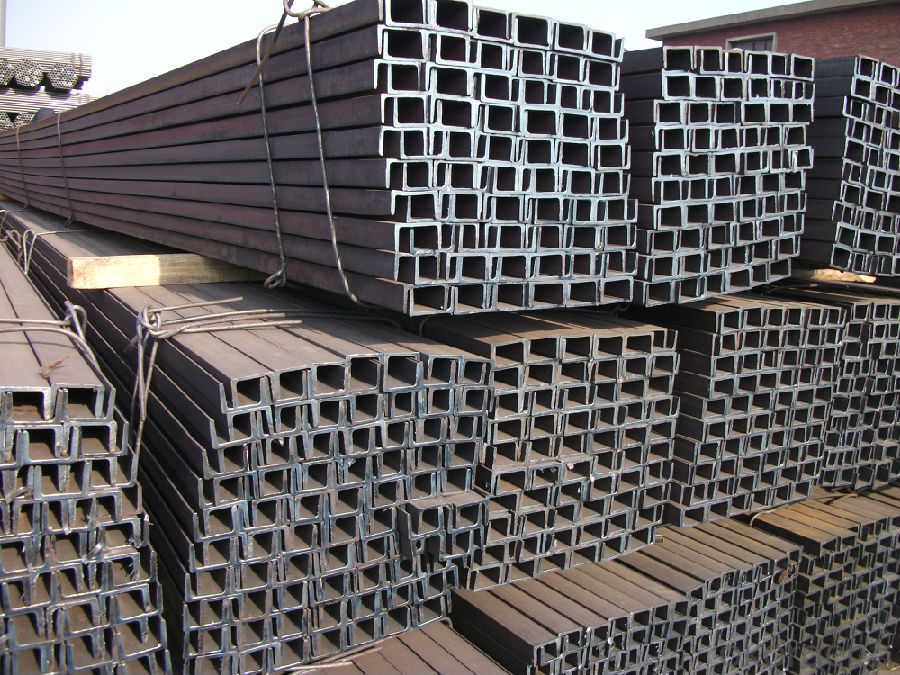
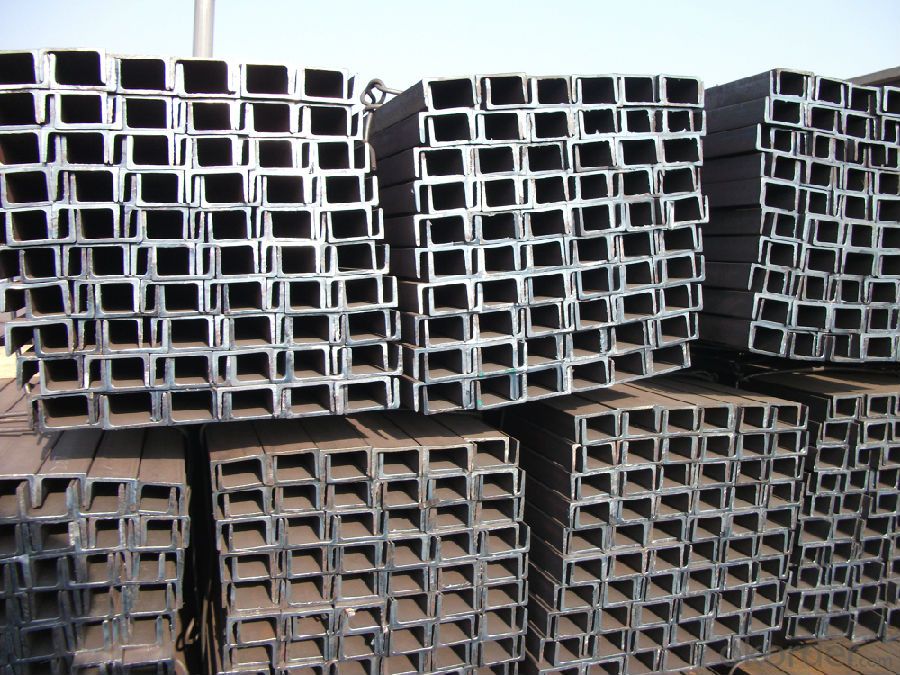
- Q: What are the common challenges in the installation of steel channels?
- Some common challenges in the installation of steel channels include the need for precise measurements and alignment, ensuring proper structural support, handling heavy and bulky materials, and coordinating with other trades or construction activities. Additionally, factors such as corrosion protection, welding or fastening techniques, and compliance with building codes and safety regulations may also pose challenges during the installation process.
- Q: Can steel channels be used for overhead crane systems?
- Yes, steel channels can be used for overhead crane systems. Steel channels are commonly used as structural components in construction and industrial applications due to their strength and durability. They provide a stable and secure framework for supporting the various components of an overhead crane system, including the bridge, trolley, and hoist. Steel channels offer excellent load-bearing capacity and can withstand the heavy loads and stresses associated with crane operations. Additionally, they can be easily fabricated and customized to meet the specific requirements of the crane system, such as length, width, and thickness. Overall, steel channels are a reliable and efficient choice for overhead crane systems.
- Q: The parameters of the channel steel of Q235B
- Q235B is carbon structural steelIt consists of Q+ numeral + quality grade symbol + deoxidization method symbol. The steel dubbed "Q", representing the yield point of steel, behind the digital representation of the yield point value, in units of MPa such as Q235 (s) said the yield point for carbon steel 235 MPa. The necessary grades can be marked behind said deoxidation methods of quality grades and symbols. The quality class symbols are A, B, C, and D respectively. Deoxidation method notation: F means boiling steel; B represents semi killed steel: Z indicates calm steel; TZ stands for special sedation steel; calm steel is not marked; Z and TZ are not standard. For example, Q235-AF indicates a class of rimmed steel.
- Q: How do steel channels compare to other building materials?
- Steel channels are highly regarded in the construction industry due to their exceptional strength, durability, and versatility. Compared to other building materials like wood or concrete, steel channels offer superior resistance to fire, corrosion, and pests. They also have a higher load-bearing capacity, allowing for greater design flexibility and the ability to construct larger and more complex structures. Additionally, steel channels are known for their consistency in quality and precision, making them a preferred choice for many builders and architects.
- Q: Are steel channels suitable for commercial construction projects?
- Yes, steel channels are suitable for commercial construction projects. Steel channels are versatile and can be used in a wide range of applications in commercial construction, including framework, support beams, and reinforcements. They offer high strength and durability, making them ideal for handling heavy loads and providing structural stability. Additionally, steel channels can be easily fabricated and customized to meet specific project requirements, allowing for efficient and cost-effective construction. Their fire resistance properties also make them a safe choice for commercial buildings. Overall, steel channels are a reliable and popular choice in commercial construction due to their strength, durability, versatility, and ease of use.
- Q: Channel 40 is used as a support leg. How many tons can each bear?
- Press the axial compression, the upper and lower are hinge bearings, double channel steel 40A buckle, Q235 steel, without considering vibration, calculated the carrying capacity is about: 1829.91kN
- Q: Can steel channels be used for column supports?
- Yes, steel channels can be used for column supports. Steel channels are often used in construction and engineering projects for their strength and durability. They provide excellent support and help distribute the load evenly, making them suitable for column supports.
- Q: 24 meters long, 4 meters per column, 6 meters wide. How large channel steel should be used to make the beam?
- The channel should not be used as bearing beam, 6 meters 4 meters across the Bay 14~16 I-steel beam available 1.2~1.5 m spacing C or Z shape.
- Q: Can steel channels be used for roof structures?
- Yes, steel channels can be used for roof structures. Steel channels are commonly used in construction for their strength and durability. They provide structural support and can be used as purlins or rafters in roof systems. Steel channels are able to withstand heavy loads and provide stability to the overall structure. They can also be easily fabricated and installed, making them a popular choice for roof construction. Additionally, steel channels are resistant to fire, corrosion, and pests, making them a reliable and long-lasting option for roof structures.
- Q: How can channel A and B be distinguished?
- Of the same height, type B has wider legs and thicker waist than A.
Send your message to us
U-channel Carbon Steel JIS Standard High Quality Hot Rolled
- Loading Port:
- Tianjin
- Payment Terms:
- TT OR LC
- Min Order Qty:
- 25 m.t.
- Supply Capability:
- 2000 m.t./month
OKorder Service Pledge
OKorder Financial Service
Similar products
Hot products
Hot Searches
Related keywords
